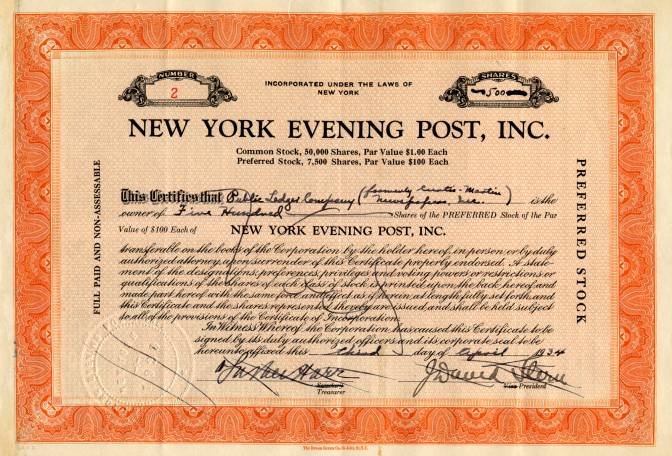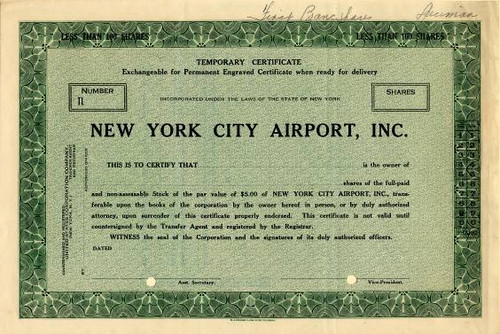Beautiful certificate from the New York Evening Post, Inc. issued in 1934. This historic document was printed by the Broun Green Company and has an ornate border around it with a vignette of the company name This item has the original signatures of the Company's President, J. David Stern and Secretary, and is over 79 years old. 
Certificate The New York Post is an American daily newspaper, primarily distributed in New York City and its surrounding area. It is the 13th-oldest and seventh-most-widely circulated newspaper in the United States.[2] Since 1993, it has been owned by News Corporation, which had owned it previously from 1976 to 1988. Its editorial offices are located at 1211 Avenue of the Americas, in New York City, New York. The Post is known for its sensationalist headlines. The New York Post, established on November 16, 1801 as the New-York Evening Post, describes itself as the nation's oldest continuously published daily newspaper. The Hartford Courant, believed to be the oldest continuously published newspaper, was founded in 1764 as a semi-weekly paper; it did not begin publishing daily until 1836. The New Hampshire Gazette, which has trademarked its claim of being The Nation's Oldest Newspaper, was founded in 1756, also as a weekly. Moreover, since the 1890s it has been published only for weekends. The Post was founded by Alexander Hamilton with about US$10,000 from a group of investors in the autumn of 1801 as the New-York Evening Post, a broadsheet. Hamilton's co-investors included other New York members of the Federalist Party, such as Robert Troup and Oliver Wolcott, who were dismayed by the election of Thomas Jefferson as U.S. President and the rise in popularity of the Democratic-Republican Party. The meeting at which Hamilton first recruited investors for the new paper took place in then-country weekend villa that is now Gracie Mansion. Hamilton chose William Coleman as his first editor. The most famous 19th-century New-York Evening Post editor was the poet and abolitionist William Cullen Bryant. So well respected was the New-York Evening Post under Bryant's editorship, it received praise from the English philosopher John Stuart Mill, in 1864. In the summer of 1829, Bryant invited William Leggett, the Locofoco Democrat, to write for the paper. There, in addition to literary and drama reviews, Leggett began to write political editorials. Leggett's classical liberal philosophy entailed a fierce opposition to central banking, a support for voluntary labor unions, and a dedication to laissez-faire economics. He was a member of the Equal Rights Party. Leggett became a co-owner and editor at the Post in 1831,[citation needed] eventually working as sole editor of the newspaper while Bryant traveled in Europe in 1834 through 1835. Another co-owner of the paper was John Bigelow.[citation needed] Born in Malden-on-Hudson, New York, John Bigelow, Sr. graduated in 1835 from Union College, where he was a member of the Sigma Phi Society and the Philomathean Society, and was admitted to the bar in 1838.[citation needed] From 1849 to 1861, he was one of the editors and co-owners of the New York Evening Post. In 1881 Henry Villard took control of the New-York Evening Post, as well as The Nation, which became the Post's weekly edition. With this acquisition, the paper was managed by the triumvirate of Carl Schurz, Horace White and Edwin L. Godkin. When Schurz left the paper in 1883, Godkin became editor-in-chief. White became editor-in-chief in 1899, and remained in that role until his retirement in 1903. In 1897, both publications passed to the management of Villard's son, Oswald Garrison Villard, a founding member of both the National Association for the Advancement of Colored People and the American Civil Liberties Union. Villard sold the paper in 1918, after widespread allegations of pro-German sympathies during World War I hurt its circulation. The new owner was Thomas Lamont, a senior partner in the Wall Street firm of J.P. Morgan & Co.. Unable to stem the paper's financial losses, he sold it to a consortium of 34 financial and reform political leaders, headed by Edwin Francis Gay, dean of the Harvard Business School, whose members included Franklin Delano Roosevelt. Conservative Cyrus H. K. Curtis--publisher of the Ladies Home Journal--purchased the New-York Evening Post in 1924 and briefly turned it into a non-sensational tabloid in 1933. In 1934, J. David Stern purchased the paper, changed its name to the New York Post, and restored its broadsheet size and liberal perspective. In 1939, Dorothy Schiff purchased the paper. Her husband, George Backer, was named editor and publisher. Her second editor (and third husband) Ted Thackrey became co-publisher and co-editor with Schiff in 1942. Together, they recast the newspaper into its current tabloid format. In 1949, James Wechsler became editor of the paper, running both the news and the editorial pages. In 1961, he turned over the news section to Paul Sann and remained as editorial-page editor until 1980. Under Schiff's tenure the Post was devoted to liberalism, supporting trade unions and social welfare, and featured some of the most-popular columnists of the time, such as Joseph Cookman, Drew Pearson, Eleanor Roosevelt, Max Lerner, Murray Kempton, Pete Hamill, and Eric Sevareid, in addition to theatre critic Richard Watts, Jr. and Broadway columnist Earl Wilson. In 1976, Rupert Murdoch bought the Post for US$30 million. The Post at this point was the only surviving afternoon daily in New York City and its circulation under Schiff had grown by two-thirds. However, the rising cost of operating an afternoon daily in a city with worsening daytime traffic congestion, combined with mounting competition from expanded local TV news rendered the Post unprofitable by 1974 (The paper has lost money ever since). Historian/activist Howard Zinn's parents introduced him to literature by sending 25 cents plus a coupon to the Post for each of the 20 volumes of Charles Dickens' collected works. One of the paper's most famous headlines, from the April 15, 1983 edition. Murdoch imported the sensationalist "tabloid journalism" style of many of his Australian and British newspapers, such as The Sun (the highest selling daily newspaper in the UK). This style was typified by Post's famous headlines such as "Headless body in topless bar" (shown on the right). In its 35th-anniversary edition, New York Magazine listed this as one of the greatest headlines ever. It also has five other Post headlines in its "Greatest Tabloid Headlines" list. History from Wikipedia and OldCompany.com (old stock certificate research service)

Certificate








